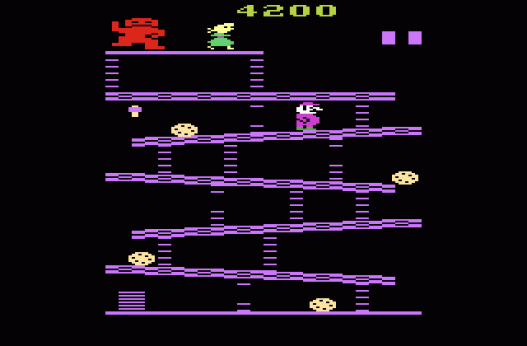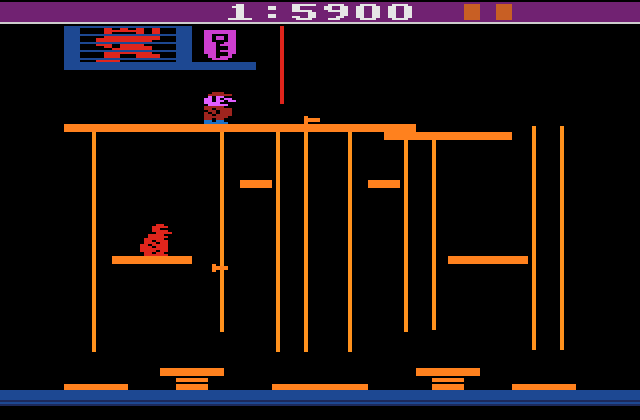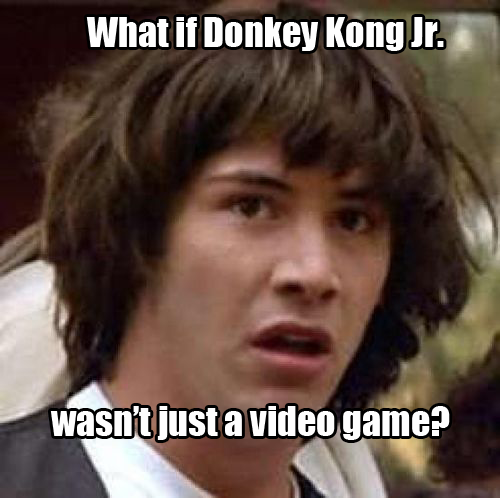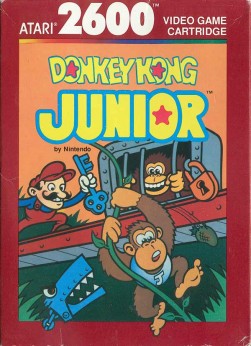
Atari Poop
Donkey Kong Jr.
To celebrate the 40th anniversary of the founding of Atari, I wanted to pick a really important game. I then found out that Donkey Kong Jr. was celebrating its 30th anniversary on the June 30th. At that point it was settled: I was going to review one of the most controversial 2600 games, a game that almost wasn’t released.
After the success of the original Donkey Kong and the subsequent backlash from animal rights activists (Donkey Kong escapes and kidnaps Jumpman’s girlfriend because Jumpman abused him and forced him to perform unspeakable acts), the folks at Atari wanted Nintendo to produce a sequel to replicate the sales but not the controversy. While very successful with the former goal, they utterly failed with the latter.
 Donkey Kong Jr. picks up right where Donkey Kong left off, Jumpman (now renamed Mario) now has Donkey Kong in a cage; however, Mr. Kong apparently got busy during the time he had escaped previously because his son is now on a quest to free his father from the evil clutches of one Italian plumber with a sick fetish. This was how Nintendo attempted to please animal rights activists, and boy, did it work, as Donkey Kong jr. was the first video game to receive the PETA seal of approval.
Donkey Kong Jr. picks up right where Donkey Kong left off, Jumpman (now renamed Mario) now has Donkey Kong in a cage; however, Mr. Kong apparently got busy during the time he had escaped previously because his son is now on a quest to free his father from the evil clutches of one Italian plumber with a sick fetish. This was how Nintendo attempted to please animal rights activists, and boy, did it work, as Donkey Kong jr. was the first video game to receive the PETA seal of approval.
Mission accomplished, great job, and pats on the back all around, right? If only it would have been that easy. The details of what followed the release of the game are still hazy today, but one fact is known: the U.S.A. tried to have Donkey Kong Jr. pulled of the shelves. In what amounts to reality reflecting The Manchurian Candidate rumours from the 60s and 70s, the American government tried to prohibit the sale of Donkey Kong Jr., but offered no explanation.
 Clearly, they were unsuccessful, as the game became a hit and was ultimately never banned. It was only decades later that some of the truth began to get exposed and it is these facts that explain the motivation behind the attempted ban: the story of the video game was eerily similar to a very strange incident that had occurred only a year earlier. The incident remained top secret for decades, which also explains why the Americans were not able to tell Nintendo or Atari why the wished the game to be banned. In the end, the U.S. decided that banning the game would only call more attention to the incident and hinder their efforts to suppress all information regarding it. However, a direct result of all this was that the C.I.A. begin to monitor spy on Nintendo employees, convinced that the only way Nintendo employees could have created Donkey Kong Jr. was with the aide of a spy.
Clearly, they were unsuccessful, as the game became a hit and was ultimately never banned. It was only decades later that some of the truth began to get exposed and it is these facts that explain the motivation behind the attempted ban: the story of the video game was eerily similar to a very strange incident that had occurred only a year earlier. The incident remained top secret for decades, which also explains why the Americans were not able to tell Nintendo or Atari why the wished the game to be banned. In the end, the U.S. decided that banning the game would only call more attention to the incident and hinder their efforts to suppress all information regarding it. However, a direct result of all this was that the C.I.A. begin to monitor spy on Nintendo employees, convinced that the only way Nintendo employees could have created Donkey Kong Jr. was with the aide of a spy.
Now that the docents regarding the incident have been declassified, we know the “truth”. Apparently, in the late 70s, the American military started a secret program where scientists worked on “cures” for a multitude of neurological diseases. They used apes in their experiments. In the early 80s, one of the apes managed to escape and caused total panic in one coastal town. The ape was eventually recaptured, but amazingly, a band of other apes and primates escape from a nearby zoo and tried to free the animals at the military lab. Official records state that this “uprising” was quickly suppressed with all of the animals involved killed, yet townsfolk still claim to hear strange noises in the forest at night. To this day, there is no evidence that the escaped ape had any contact with the zoo animals.
Many of you have probably heard of this incident recently. A documentary about it starring James Franco (whose name is an anagram for Cajones Farm, btw) was released in 2011. Give Franco a mustache and he kinda looks like Luigi, doesn’t he?

